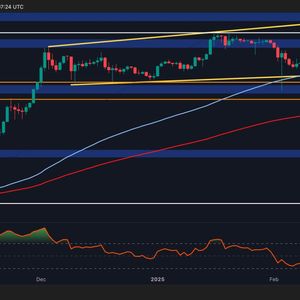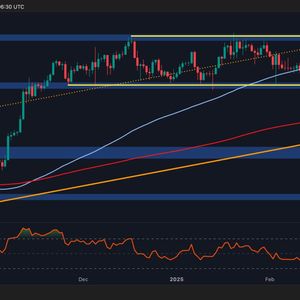In a move that sent ripples through financial markets, the Bangko Sentral ng Pilipinas (BSP), the Philippine central bank, has announced a dramatic 200 basis points (bps) reduction in the Reserve Requirement Ratio (RRR) for banks. For cryptocurrency enthusiasts and investors closely watching global economic trends, this decision is not just a local event; it’s a significant indicator of potential shifts in liquidity and economic strategy within the region. Let’s dive deep into what this Philippine central bank RRR cut means, why it matters, and how it could impact the broader financial landscape. Understanding the Impact of the Reserve Requirement Ratio (RRR) Before we delve into the specifics of the BSP’s decision, it’s crucial to understand what the reserve requirement ratio actually is. In simple terms, the RRR is the percentage of a bank’s deposits that it is required to keep with the central bank as reserves. This money cannot be lent out to borrowers or used for investments. Think of it as a safety net that ensures banks have enough funds to meet their obligations and maintain financial stability. The RRR is a powerful tool in the hands of central banks to manage liquidity in the financial system and influence economic activity. A higher RRR means banks have less money to lend, which can slow down economic growth, while a lower RRR does the opposite, potentially boosting lending and economic activity. Why Did the Philippine Central Bank Implement This Massive Cut? The question on everyone’s mind is: why now, and why such a significant cut? A 200 bps reduction is not a minor adjustment; it’s a bold move signaling a potential shift in the BSP’s monetary policy stance. Several factors could be at play here: Stimulating Economic Growth: The most immediate and likely reason is to inject liquidity into the financial system and stimulate economic growth. By lowering the RRR, banks suddenly have access to a larger pool of funds that they can lend out. This increased lending can fuel business expansion, consumer spending, and overall economic activity. In a post-pandemic world where economies are still recovering, such measures can be seen as proactive steps to ensure robust growth. Managing Inflationary Pressures: While seemingly counterintuitive, a rate cut can sometimes be used to manage inflation indirectly. In certain scenarios, if the central bank believes that inflation is being driven by supply-side issues rather than excessive demand, boosting liquidity might help ease these pressures by facilitating smoother business operations and supply chains. However, it’s crucial to note that this is a delicate balancing act, as too much liquidity could also fuel inflation. Supporting the Banking Sector: Lowering the RRR can also provide relief to the banking sector itself. It frees up capital that banks can use to improve their profitability, strengthen their balance sheets, or invest in new technologies and services. This can be particularly beneficial in a challenging economic environment where banks might be facing increased risks and tighter margins. Global Economic Headwinds: The global economic landscape is currently fraught with uncertainties – from geopolitical tensions to supply chain disruptions and fluctuating commodity prices. The BSP might be taking a preemptive step to bolster the domestic economy against potential external shocks. By making more funds available domestically, the central bank aims to create a buffer against global economic volatility. Digging Deeper: The Mechanics of the RRR Cut Let’s break down how this Philippine central bank RRR cut actually works in practice. Imagine a hypothetical bank in the Philippines with deposits of PHP 100 billion. If the RRR was previously at, say, 12%, the bank would have been required to keep PHP 12 billion as reserves with the BSP. With a 200 bps (or 2%) reduction, the RRR now becomes 10%. This means the reserve requirement drops to PHP 10 billion. Suddenly, the bank has an extra PHP 2 billion at its disposal. This PHP 2 billion can now be used for: Increased Lending: The bank can lend more money to businesses and individuals, offering loans for various purposes like business expansion, home purchases, or personal consumption. Investments: Banks can invest the freed-up capital in various financial instruments, potentially boosting market activity. Operational Improvements: The additional funds can also be used to improve bank operations, upgrade technology, or expand services. The overall effect is a significant increase in the amount of money circulating in the economy, often referred to as increased bank liquidity . Benefits of the RRR Reduction: A Silver Lining? This BSP monetary policy move is expected to have several positive outcomes, at least in the short to medium term: Boost to Economic Activity: Increased lending can stimulate business investment and consumer spending, leading to higher economic growth rates. Sectors like real estate, infrastructure, and manufacturing could see a surge in activity as access to credit becomes easier and cheaper. Lower Borrowing Costs: With more liquidity in the system, interest rates on loans might decrease, making borrowing more affordable for businesses and individuals. This can further incentivize borrowing and spending, driving economic momentum. Increased Investment: Both domestic and foreign investors might view this move as a positive signal, indicating the BSP’s commitment to supporting economic growth. This could attract more investment into the Philippines, further fueling economic expansion. Potential Stock Market Rally: Historically, expansionary monetary policies like RRR cuts have often been associated with stock market rallies. Increased liquidity and optimism about economic growth can drive investor sentiment and boost stock prices. Challenges and Potential Risks: Navigating the Tightrope While the Philippine economy stands to gain from this RRR cut, it’s essential to acknowledge the potential challenges and risks associated with such a significant monetary policy shift: Inflationary Pressures: The most significant risk is the potential for increased inflation. Injecting a large amount of liquidity into the economy can lead to a surge in demand, which, if not met with a corresponding increase in supply, can push prices higher. The BSP will need to closely monitor inflation indicators and be ready to adjust its policy if inflationary pressures become excessive. Currency Depreciation: Increased liquidity and potentially lower interest rates could make the Philippine Peso less attractive to foreign investors, potentially leading to currency depreciation. A weaker Peso can make imports more expensive, contributing to inflation. Asset Bubbles: Excess liquidity can sometimes lead to asset bubbles, particularly in sectors like real estate or the stock market. If asset prices rise too rapidly and become unsustainable, it could lead to financial instability down the line. Over-reliance on Monetary Policy: While monetary policy is a crucial tool, over-reliance on it can be problematic. Sustainable economic growth requires a combination of sound fiscal policies, structural reforms, and a conducive business environment. The RRR cut should be seen as one part of a broader strategy, not a standalone solution. Actionable Insights for Crypto and Forex Traders For those involved in cryptocurrency and forex trading, the BSP monetary policy shift offers several actionable insights: Monitor Peso Volatility: Keep a close eye on the Philippine Peso (PHP) exchange rates. Increased liquidity and potential interest rate adjustments could lead to fluctuations in the Peso’s value. Forex traders should be prepared for potential volatility and adjust their strategies accordingly. Assess Inflation Impact: Track inflation data in the Philippines closely. If inflation starts to rise significantly, it could prompt the BSP to reverse course and tighten monetary policy, which could have implications for asset prices across the board, including cryptocurrencies. Watch Stock Market Performance: The Philippine Stock Exchange (PSE) could see increased activity and potentially higher valuations in the short term. This could indirectly influence investor sentiment in other asset classes, including cryptocurrencies. Consider Philippine Investments: For those looking at investment opportunities in emerging markets, the Philippines might become more attractive due to increased liquidity and potential economic growth. This could extend to interest in local cryptocurrency adoption and development. Conclusion: A Bold Bet on Growth The Philippine central bank’s decision to slash the RRR by 200 bps is undoubtedly a bold and impactful move. It reflects a clear intent to stimulate economic growth and inject much-needed liquidity into the financial system. While the potential benefits are significant – including boosted economic activity, lower borrowing costs, and increased investment – the risks, particularly concerning inflation and currency depreciation, are equally real. The BSP will need to navigate this delicate balance with skill and vigilance. For observers of the global financial landscape, and especially those in the cryptocurrency and forex markets, this move serves as a crucial case study in how central banks are adapting their policies in a rapidly evolving economic environment. The coming months will be critical in assessing the true impact of this decisive action and its implications for the Philippine economy and beyond. To learn more about the latest Forex market trends, explore our articles on key developments shaping currency valuations and global liquidity.

















